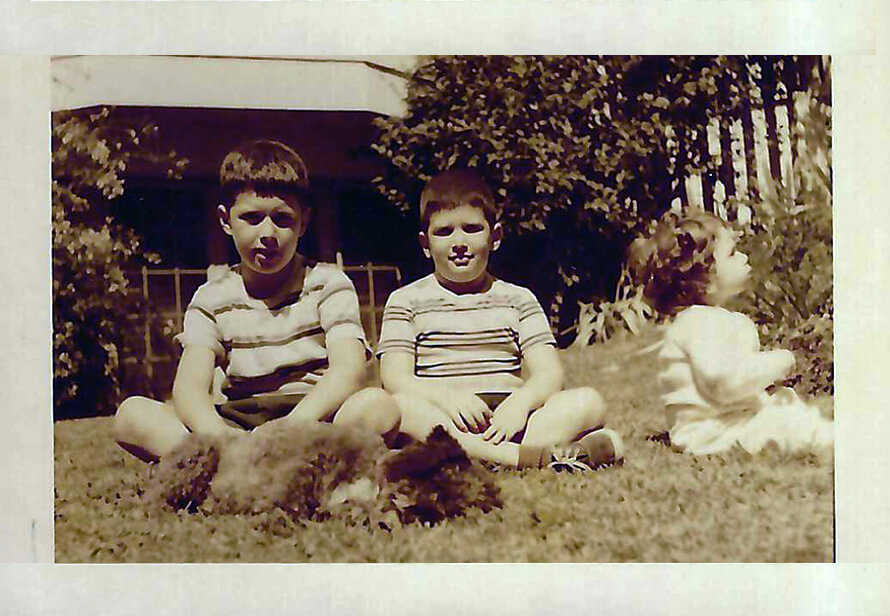I grew up in the suburbs of New York City where five of us lived in a three-bedroom, two-and-a-half-bath single family home with our dog Bobo and an occasional cat. Behind our backyard was a wooded patch, a ramble of oak, maple, beech, and various shrubs; in the spring, skunk cabbage would pop up in its water-logged lower end, and yellow flowers of tiny forest lilies would nod towards the ground.
From the earliest I can remember, our backyard housed a vegetable garden planted by my mother. She’d plant peppers, cucumbers, green beans, and tomatoes, all of which would variously appear on the dinner table. At the far end of the vegetable garden grew some raspberries, and despite the thorns, I’d pick and eat them as they ripened each year. It was glorious.
My father Norman was the breadwinner, my mother Flory a housewife. He’d leave every weekday morning at 7:30 to travel to Manhattan, where he and his brother ran a freight forwarding company started by my grandfather Bill. Bill, a Jewish immigrant, arrived at Ellis Island from Eastern Europe in 1910 at twelve years old, his eight-year-old sister in tow, after a 38-day passage in steerage, the lowest inhabitable area of the ship. Neither spoke any English.
My family’s story is like that of many others; I was raised within a meritocracy that rewarded hard work and the advantages of luck. Our single-family home with its backyard represented the fulfillment of the American Dream, a patch of land we called our own. In that sense, those raspberries symbolized the success of self-reliance and imparted a taste of freedom that began with Bill’s escape from the antisemitic pogroms of Russia.
The dream of a single-family home lives on, but in our increasingly stratified economy, meritocracy has been challenged by ideas of privilege. Bill, of course, was anything but privileged. After arriving, his family lived in a basement tenement with damp walls on Manhattan’s lower East Side; he learned a new language and over time built a better life for himself and his family. Several years after my father was born in 1919, the family moved into a single-family home with a small backyard on East 29th Street in Brooklyn, where my Grandmother Hannah planted tomatoes.
I’ve enjoyed privilege stretching back to Bill and Norman, the benefits of their hard work and success. Moreover, 45 years of work behind us, my wife and I have built on that legacy, owning a single-family home with a backyard. And yes, there are tomatoes.
Strangely, the single-family home has now been branded an element of privilege, along with the meritocracy that built it. America’s social argument is now centered on equity, the equity of opportunity. From the view of privilege, meritocracy unfairly produces winners and losers. Without the social and economic exploitation of others, the argument goes, meritocracy would fail.
Politically, this process is now playing out with measures such as California’s Senate Bill 9 (SB9), which turns the idea of single-family homes on its head by monetizing backyards and permitting four residences on a single-family parcel by right. Promoted as a housing equity solution, it remains unclear who will take advantage of the provisions of SB9; indications are that corporate America is gearing up. So much for backyard garden tomatoes.






“Racial inequality is a well-known fact of life in America, and the Bay Area is no exception. What is often overlooked, however, is the role of racial residential segregation in shaping these outcomes.”
“All the data points in one direction: racial segregation in the Bay Area, like the rest of the country, accompanies a hoarding of resources by some communities at the expense of others, thereby resulting in consistently negative outcomes for people of color. The perpetuation of this unequal access to opportunity has real effects on people’s current lives, and the ability for their families to succeed in the future. At the same time, racial segregation contributes to the concentration of poverty for marginalized groups, which also produces deleterious effects above and beyond the absence of life-enhancing resources.”
https://belonging.berkeley.edu/racial-segregation-san-francisco-bay-area-part-4
Larry and I learned we both grew up in Westchester County, NY, the Marin County of NYC. Larry from Scarsdale, me from White Plains. If you read the linked ProPublica article, Scarsdale was to White Plains as Rye is to Port Chester today. Do the people who ended up in these respective towns do so bc of choice, freedom, and meritocracy? Or is that a Scarsdale apology for segregation, the same that we see in Sonoma?
In his book Golden Gates, the Housing Crisis and a Reckoning for the American Dream, Conor Dougherty calls the Sonoma/ Scarsdale exclusionary zoning pattern “go’vt sanctioned apartheid.” Dougherty points out how in CA, exclusion has now taken on a race neutral lexicon, while maintaining the same segregation that in the past had more overtly racist tomes. Richard Rothstein in The Color of Law, A Forgotten History of How Our Gov’t Segregated America, seconds all this, as does the state with Affirmatively Furthering Fair Housing law. There is still a problem with exclusion and Elite Enclaves and it’s not all about how early we get up in the morning to hustle and succeed.
Larry and I disagree, as Scarsdale and White Plains would. I agree with Ta-nahisi Coates. In his book We Were Eight Years in Power, An American Tragedy, Coates says, “To ignore the fact that one of the oldest republics in the world was erected on a foundation of white supremacy, to pretend the problems of dual society are the same as the problems of unregulated capitalism, is to cover the sin of national plunder with the sin of national lying.”
Race is clearly a core issue in housing, esp in essentially white towns like Sonoma, yet Bay Area liberals that benefit from racial exclusion are loath to admit it. Real US race-housing history should be on the table; we need see the actual. This then defines and establishes a core moral and ethical dimension to housing issues, that all sit under the banner of Equity. This project has been surprisingly hard. Elite Enclave folks are defensive, won’t include race as an issue bc if they do, it undermines the whole class-meritocracy argument house of cards.
As the city and county proceed with the Housing Element process, whatever side you may be on, look at the interests at stake. Know Mile’s Law: “where you stand depends in where you sit.” At the end of the day there are various shades of haves and have nots, all with arguments to explain and justify themselves. Study the interests, study the history, look at the residential patterns, go to the American Planning Association website, get educated, then as you look at housing issues you can take Jose Ortega y Gassett’s advice: “So many things fail to interest us, simply because they don’t find in us enough surfaces on which to live and what we have to do then is to increase the number of planes in our mind, so that a much larger number of themes can find a place in it at the same time.”
“Beveridge said Westchester County’s racial divisions cannot be explained by benign settlement patterns. The county includes heavily black and Latino cities such as Mount Vernon (63 percent black and 14 percent Latino), Yonkers (19 percent black and 35 percent Latino) and New Rochelle (19 percent black and 28 percent Latino) and it borders on the Bronx (43 percent black and 54 percent Latino).
“Bordering these cities are Scarsdale (1.5 percent black and 4 percent Latino), Bronxville (1.4 percent black and 4.4 percent Latino) or Eastchester (1.3 percent black and 7 percent Latino).
“The county’s political leaders insist these statistics reflect class, not race; African Americans and Latinos cannot afford to live in towns like Scarsdale, one of the nation’s wealthiest suburbs, they say.
“But the connection between race and class can be nearly inextricable, particularly when certain zoning requirements — called “exclusionary zoning” by fair-housing advocates — are present, as they are in Westchester County.
https://www.propublica.org/article/soft-on-segregation-how-the-feds-failed-to-integrate-westchester-county
I agree that the actual city of Sonoma demographics is overwhelmingly white. However, if you look at the Sonoma Valley, a bigger picture emerges that reflects reality more accurately. Within the Sonoma Valley, the racial makeup was 46.3% White, 49.1% Hispanic, and 2.7% Native American by the 2010 census. And my street in the town of Sonoma reflects this exactly. We live in a multi race diverse neighborhood of hispanics, whites, south sea islanders, and native Americans. We also have beavers in our back yard so I feel compelled to say multi species as well. There is no doubt in Mr Allebach assertion that our culture and society is built on the backs of murdered native Americans and black slaves as there is no getting around those historical facts. However, to say that Sonoma itself is a racist community is a solid false hood. Sure, there are racists in every community of all racial makeups but for Mr Allebach to point out that whites in Sonoma are racists and squeezing out people of color is blatantly misleading. Every community in America tends to have neighborhoods made of people who tend to gravitate to familiarity and similarities. Aka, China town, Korean town, and towns like Freemont made of Afganistan people and towns like Stockton made up of made South Asian people. It happens all over the world – it is not unique to America. In Paris there are whole neighborhoods of people from different parts of Africa. Perhaps Mr Allebach might benefit from getting his head out of so many books and get out and travel the world and find out that Sonoma is just like many places in the world. Mr Allebach willl probably write me off as a troll as he has done in the past but that is just because we both went to the same elite private prep school in upstate New York. The same prep school that Leonard Bernstein sent his son, far away from Scarsdale or White Plains..
My Grandparents immigrated from Austrian Galicia in 1910. They were Ukrainians. My other grandmother from Belgium and my grandfather from Holland. They moved to the other New York State. Rochester New York. They avoided WWI and survived the Great Depression and their Veteran children prospered. 50 years ago, I lived in San Francisco where I went to Law School. The cost of living was manageable for most Californians. They could afford houses and rents, The big change occurred during the 70’s. Housing prices soared due to demand and inflation. If you bought in the early 70’s you were in the game. Otherwise, you never made up for the price increases. Some people I know paid $35000 for a home in Berkeley. Others in Sonoma. But many have never owned a home. Now the population has doubled but there are few places to build affordable housing.
Sonoma is quit diverse. There are “locals”, transplants from California, Foreign Countries and other states. Many like me stumbled on Sonoma and decided this is a wonderful small town. People are friendly, caring and involved. I have made many friends in Sonoma. The racial makeup up Sonoma may be white, Italian and Catholic but not by design. I haven’t found Sonoma any more or less racist than other places I have lived. There may be more whites than Hispanics. But there are many degrees of Hispanics. Many long standing people who have a Hispanic heritage live in Sonoma. More recent arrivals not so much. I marvel at how many native Californians there are whose families came here many generations ago.